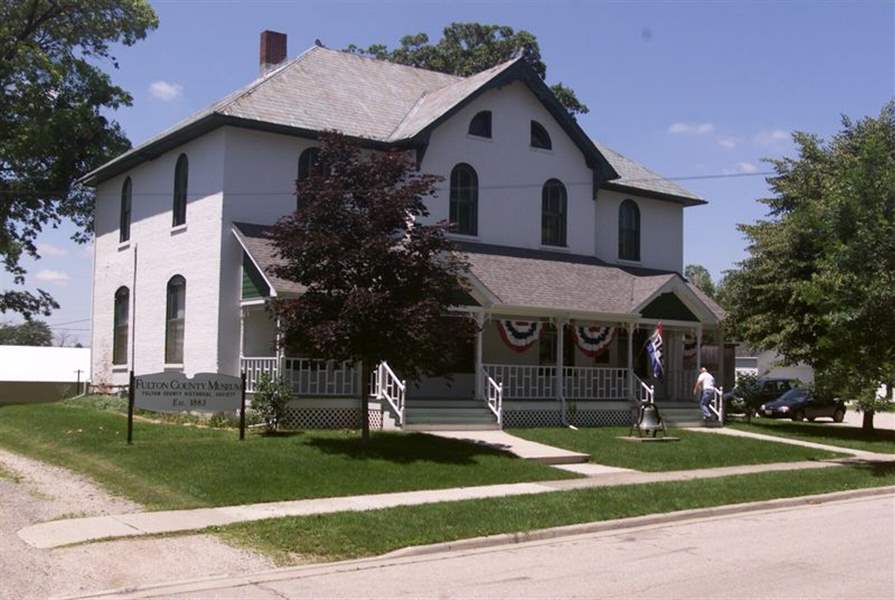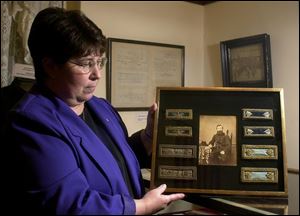
Area museums cutting back in face of reduced resources
5/29/2005
The Fulton County Historical Society decided to close the Wauseon museum on Fridays.
LORI KING

Barbara Berry, director of the Fulton County Historical Society, shows a photo of E.L. Hayes, one of Wauseon's founders and a Civil War veteran. The photo was found on eBay.
WAUSEON - This spring hasn't been Fulton County Historical Society's favorite period in history.
Last week, the society board decided to close the Wauseon museum doors on Fridays, effective immediately, because of a cash crunch museum Director Barbara Berry blamed on reduced government funding, corporate sponsors, and individual memberships.
"It just about kills you, but I've heard: 'Well, you're a nonessential service,' " Ms. Berry said.
She's one of many area museum directors facing the start of the summer tourist season with fewer resources.
Sauder Village in Archbold is closing on Mondays - except for holidays - for the first time since it opened in 1976. Attendance at the historical village was steady last year after a sharp dip in 2002 but hasn't climbed back to earlier levels of about 100,000 in the regular season.
The Wolcott House Museum Complex in Maumee reduced its guided tours to two a day, down from three a day last year. It's the third-straight year the complex has made cuts - and they've all remained in effect. Last year, it closed the office on Tuesdays; the year before it closed the museum on Wednesdays.
Even at the Allen County Museum in Lima, one of the best-known county museums in the area which has embarked on a $6.5 million renovation and expansion, cuts made in staff hours two years ago remain in effect.
More historical societies that have held off on cuts are worrying over how much money the Ohio General Assembly will pass on to local counties and cities in coming years.

The Fulton County Historical Society decided to close the Wauseon museum on Fridays.
If those budgets - which are to be set next month - take big hits, it will only be a matter of time before more museums feel a bigger pinch from local government.
"When history competes against police and fire and safety history often comes up short," said Kathy Hoke, a spokesman for the Ohio Historical Society.
That's part of what happened in Fulton County.
The county commissioners budgeted $25,000 for the historical society this year, down from $30,000 last year, a 17 percent reduction.
"They had to take a hit like everybody else," said Jack Graf, the board of commissioners' president. He said commissioners will try to give the museum $25,000 again next year - or $30,000 if tax receipts increase - but such plans depend on the county's revenue.
That's only the beginning of the woes for the historical society, which was established in 1883 and claims to be the 13th oldest in Ohio.
Annual memberships have been halved: about 50 have paid their $30 family, $20 individual, or $5 student dues, down from 100 members last year.
Businesses that have sponsored the museum in the past are apologizing, saying they're inundated with such requests: Eight have assisted this year compared to 30 last year.
Perhaps even more disturbing, the number of visitors has been low. An open house on May 1 kicked off the historical society's season with a crowd of 75. But the tally for the rest of the year to date is 30 people, most of whom were researchers. Through all of last year, including special events, the museum drew 700 people.
Dreams of a $750,000 expansion and renovation that the museum announced three years ago for the 1868 Romanesque Revival building on Monroe Street never have been pursued.
The scenario is so disturbing to Ms. Berry, who is the museum's only employee, that she asked board members last week if they wanted to reduce her hours. Without changes, she said she feared the society might run out of money and return to opening only on Sundays - a day it is now closed - as it had for years.
Board President Marv Leatherman said the society doesn't plan to reduce Ms. Berry's hours.
But the savings from closing on Fridays without cutting her pay appear negligible.
Mr. Leatherman and Ms. Berry said maintaining what is now a Monday-through-Thursday schedule at the museum would allow the society to save on utilities.
The Rutherford B. Hayes Presidential Center in Fremont tried such an idea once and decided it didn't work. The presidential center, which like many historical attractions has experienced funding cuts and reduced visitors since 2001, closed the Hayes home on Mondays one winter.
But museum leaders decided it had a bigger effect on the public's perception of the museum than it did on their bottom line, said Nancy Kleinhenz, communication and marketing manager.
Museum goers remembered they'd heard something about closing but forgot that it was Mondays only, she recalled. Meanwhile, utility bills varied little because museum leaders wanted to keep temperatures fairly constant to protect the artifacts, whether there were visitors or not.
The Hayes center returned to being open seven days a week, despite what Ms. Kleinhenz called drastic state funding cuts.
How much money area museums receive from taxpayers varies dramatically, from the Williams County Historical Society in Bryan, which receives hundreds of dollars a year from local taxpayers, to the Wood County Historical Center and Museum near Bowling Green, which receives hundreds of thousands.
Other area museum boards haven't worried a bit over government budgets or corporate fortunes.
Historic Lyme Village near Bellevue in Huron County, near the Erie County line, is one of those: It doesn't get taxpayer money or have corporate sponsors.
It's never been open on Mondays and never had a paid staff.
Yet it drew 1,200 students who paid $4 each for school tours this spring after the museum changed its presentation to more closely reflect classroom curriculum, board President Ray Parker said.
More new programs are planned for the rest of the year, including a bluegrass festival in July, that Mr. Parker said have energized the museum's 50 volunteers and 250 members who support it along with private grants.
Last year, the board put a new roof on the village's Victorian mansion, built in 1880. The cost: $73,000.
The museum sent a letter to supporters in October, 2003, and started work the next month. The project was finished last summer, and much to Mr. Parker's delight, the bill was paid off in April, less than 18 months after the first request. Although there were three donations of $5,000 each, the bulk was paid off with smaller contributions.
The secret, Mr. Parker said, is to try new approaches when a funding stream dries up - or never appears.
Lyme's board hoped for corporate sponsors but "we've tried and tried and nobody wants to sponsor us," he said. So village leaders focused their efforts on private foundation grants and have had success there.
"I think a lot has to do with leadership and attitude," Mr. Parker said.
Contact Jane Schmucker at: jschmucker@theblade.com or 419-337-7780.